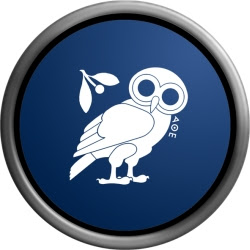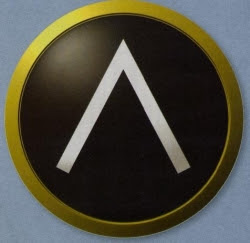Ajax, son of Telamon, King of Salamis, and, according to Homer, a man of enormous stature and a colossal body, was inferior in strength and bravery only toAchilles. Ajax fought against Hector and, by the help of Athena, he saved Achilles΄body from the hands of the Trojans. Ajax lost in a contest with Odysseus for the possession of Achilles΄ panoply, and committed suicide. According to a later version, his disappointment led him to madness. When he recovered his senses, he committed suicide, by throwing himself on a sword that had been a present fromHector.
Ajax Telamonius was the patron hero of Salamis island, where a temple and a statue were erected in his honour, while Aianteia was an annual festivity. A town in Salamis is still called Aianteion.
Ajax participated in the Trojan War and the siege of Troy. He also possessed an extraordinary shield, described with great clarity in the Iliad, and sufficient details to perform a numerical simulation. Since the materials specified are not as expensive,as compared to the gold content of the shield of Achilles, and the construction much simpler, it was possible to produce specimens and perform an experimental study, to confirm analytical results and, in particular, to investigate the mechanism of energy dissipation of the impactor, which is radically different than the one of Achilles΄ shield. The Homeric description follows:
“Ajax came up bearing his shield in front of him like a wall- a shield of bronze with seven folds of oxhide- the work of Tychius, who lived in Hyle and was by far the best worker in leather. He had made it with the hides of seven full-fed bulls, and over these he had set an eighth layer of bronze”. (Iliad, 7, 219-223).
“He poised his spear as he spoke, and hurled it from him. It struck the sevenfold shield in its outermost layer- the eighth, which was of bronze- and went through six of the layers but in the seventh hide it stayed. Then Ajax threw in his turn, and struck the round shield of the son of Priam. The terrible spear went through his gleaming shield, and pressed onward through his cuirass of cunning workmanship; it pierced the shirt against his side, but he swerved and thus saved his life. They then each of them drew out the spear from his shield, and fell on one another like savage lions or wild boars of great strength and endurance: the son of Priam struck the middle of Ajax's shield, but the bronze did not break, and the point of his dart was turned.” (Iliad, 7, 224-259).
Hence, the shield is also a multi-layered structure, consisting of eight consecutive laminates, e.g., of a front laminate of hard bronze and seven layers of calf΄s leather.As shown in the sequence, both numerically and experimentally, the Homeric descriptions of the behavior of various shields in battle are confirmed with surprising accuracy and, once more, reveal elements of advanced scientific and technological knowledge.
Analysis of results
In this paragraph the impact of Hector΄s spear on Ajax΄s shield is analyzed. The same assumptions as with Achilles΄ shield were adopted, concerning shape and dimensions of spear and shield, and data from the modern javelin-throwing sport have been utilized.
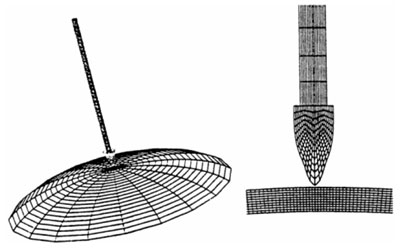 | Fig. 1 Finite Element discretization of thespear-shield system: The complete three-dimensional model (left) and a detail of spear-head (pike) and shield contact point (right) |
Fig. 2 Impact behaviour of spear-shieldsystem, with all shield’s laminatespossessing the properties of bronze, at 4msec time after the beginning of the phenomenon, by which the spear pierces the shield. | 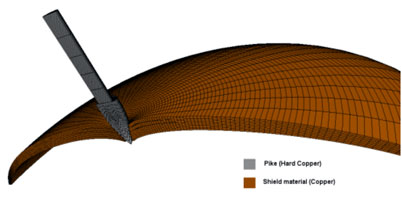 |
It was assumed that the seven leather layers of the shield were of equal thickness, varying from 1 to 1.5 mm . With a circular shield and a spear hitting it at a direction normal to its surface, the problem is axisymmetric. The form of the generatrix of the shield cross section is elliptic with semi-axes 300 and 120 mm . Details of shield cross section and the spear head, as well as their 3-dimensional discretization, are given in Figs 1 and 2, concerning results for layers of bronze only(read also The shield of Achilles). Also, in Fig. 3, as an example, the results for onebronze laminate and four leather layers are given. In the present analysis, as the main factor of spear motion attenuation, the friction between the leather layers was considered, which in this case is the main mechanism to convert its kinetic energyinto heat.
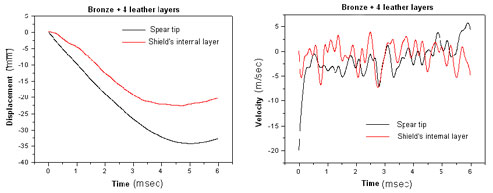
Fig. 3 Penetration diagram of a simulated shield,
consisting of 1 bronze laminate and 4 leather layers.
Experimental
To test the penetration resistance, a series of specimens were manufactured,having the same multi-layer structure consisting of one laminate of hard bronze and a number of layers of calf leather. To investigate the mode of operation of the shield and of the spear penetration mechanism, various combinations of number and thickness of layers were examined. In fact, by maintaining the total thickness of leather layers constant, e.g., 7 mm , different forms of specimens, presented in Fig. 4 were experimentally tested. Τhe latter were impacted by hard bronze projectiles launched by an air-gun.
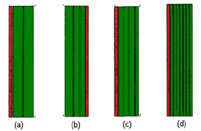 | Fig. 4 Several specimen forms: Bronze laminate (red) is |
The experimental setup appears in Fig. 5 (left) and consists of the air-gun, a specimen clamping jig and a system to measure projectile velocity. The air-gun has a compressed-air vessel and a barrel. (Designed by the late Professor Werner Goldsmith, University of California at Berkeley in 1981 during his sabbatical year in Patras.) The vessel is equipped with an electric detonation valve and a pressure gauge. The air-gun accepts barrels of different diameters and length. In this case, the barrel was 2 m long and had a diameter of 13.4 mm . Compressed-air was supplied by a central distribution line. The specimen clamping jig with part of the barrel appears in Fig. 5 (right).

Fig. 5 The air-gun (left) and a specimen clamping jig (right).
The air-gun shoots cylindrical projectiles with a conical tip made of bronze harder than shield bronze (Fig. 6, left). To measure the projectile velocity, a splitHe-Ne laser beam and two photodiodes with their respective outputs fed into a CRToscilloscope were used. The initial projectile velocity of a given mass projectile, again, corresponded to kinetic energy equal to that of the javelin of the year 2000 world champion, or 39.38 Joule. The photograph of a penetration hole appears on a bronze surface in Fig. 6 (right).
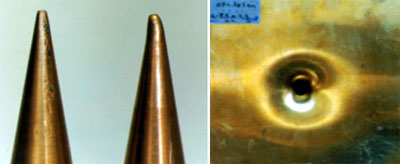
Fig. 6 The projectile before and after impact (left) and
a penetration hole on bronze surface (right).
a penetration hole on bronze surface (right).
Discussion of results and conclusions
A measure of the projectile penetration into the respective specimen is the size of the hole created on the surface bronze laminate (Fig. 6, right). Τhe results for the various specimens appear in Fig. 4. It is interesting that for the multi-layer shield with seven leather layers, i.e., Ajax΄s shield, penetration assumes a maximum value. However, this was the specimen that resisted penetration, and, in reality, was the last leather layer that eventually stopped the projectile. This agrees admirably with the Homeric description of its battle behaviour, stating that:
[Hector] “poised his spear as he spoke, and hurled it from him. It struck the sevenfold shield in its outermost layer- the eighth, which was of bronze- and went through six of the layers but in the seventh hide it stayed”. (Iliad, 7, 244-247).
Fig. 7 Penetration hole diameter on the surface of a bronze laminate against number of leather layers. | 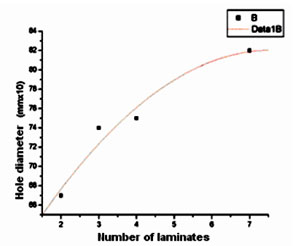 |
With the shield of Ajax, the kinetic energy of the projectile is absorbed by the friction between the layers of leather, acting efficiently for a number of layers equal to or greater than seven and with sufficient deformation of the layers. On the other hand,a polynomial interpolation in the results of Fig. 7, shows that, for a greater number of leather layers, penetration tends to assume constant value. This proves that the structure described in the Iliad provides maximum resistance towards penetration, being also an optimum solution, since, for a greater number of layers, friction would be too strong and the structure too rigid to deform sufficiently and consume kinetic energy through friction. It is also noted that a small part of the projectile kineticenergy is absorbed by the deformation of the projectile tip, mentioned in Iliad 7,259and appears in Fig. 6.
Again, the hypothesis is confirmed, that the shield manufacturer (in this case, notHephaestus, a god, but Tychius, a simple tanner), was fully aware of the dynamic mechanical behaviour of multi-layered composite structures.
Dr S. A. Paipetis
Dept. Mechanical Engng & Aeronautics


